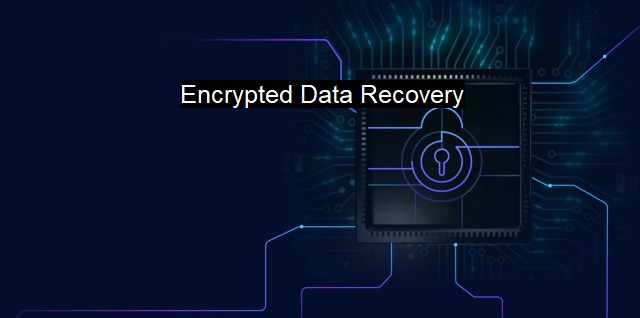What is Encrypted Data Recovery?
The Importance of Encrypted Data Recovery in Today's Cybersecurity Landscape: Restoring Your Information Safely
"Encrypted Data Recovery" is a term that refers to the process of restoring, recovering, or unlocking encrypted data that has been tampered with or cannot be accessed due to being compromised by threats such as hacking or system malfunctions. This process is crucial in the realm of cybersecurity and is used to keep confidential or sensitive digital data safe from security breaches and exposure.To fully grasp the concept of encrypted data recovery, it is important to first understand what encryption is. encryption is a method used to convert original data, also known as plaintext, into coded data or ciphertext, using a cipher and an encryption key. This method is used to ensure that user information or data is securely transmitted or stored, and only authorized users with the respective decryption key can convert the ciphertext back into its original form. Encryption is a fundamental aspect of cybersecurity used to safeguard sensitive data against unauthorized access.
Now, while encryption serves to protect data and ward off malign actors, it also creates challenges when that protected data is lost or corrupted. Since the encrypted data can only be cracked or recovered using the specific decryption key, losing the key or having it compromised can make accessing the data almost impossible. This is where encrypted data recovery comes into play.
In encrypted data recovery, professionals use specified techniques and tools to restore, recover or "unlock" encrypted data without having access to the decryption key. The success rate of this recovery process greatly depends on the complexity of the encryption algorithm used in ciphering the data.
Recovery of encrypted data involves tackling two major issues: data loss or data accessibility. Data loss could occur as a result of system crashes, hardware malfunctions, virus attacks, or even accidental deletion. In such cases, data recovery techniques are used to retrieve lost information from the storage medium even if it is encrypted.
On the other hand, data accessibility problems arise when the data is in place, but users are locked out due to reasons such as forgotten passwords or lost decryption keys. Access issues may also occur when malware or other malicious attacks corrupt the encryption software or compromise the decryption keys.
Emerging recovery methods for encrypted data employ both software and hardware strategies. In software-based encrypted data recovery, different software tools undertake tasks such as brute force attacks where they try multiple key combinations till the right one is found; dictionary attacks, where they try out all the words in a dictionary as potential keys, or cryptanalysis, where they endeavor to find a weakness in the encrypting algorithm itself. In hardware-based recovery, professionals can bypass the digital protection measures by directly accessing the storage medium that contains the encrypted data.
Expectedly, successful encrypted data recovery demands a formidable understanding of encryption algorithms, proficiency in using recovery tools, and extensive experience in dealing with different data recovery situations. It's a procedure typically done by professionals in data recovery or cybersecurity firms.
In an age where data has become a critical part of organizational and personal functions, encrypted data recovery is more important than ever. Even as individuals, corporations, and governments leverage encryption to protect their sensitive data, the need for recuperating access to this data persistently prompts the development and enhancement of encrypted data recovery technologies. In a context where data is coined as the 'new oil', recovering lost or inaccessible encrypted data becomes an imperative aspect of smooth operations in any digital-driven environment. Consequently, encrypted data recovery continues to remain a crucial part of the broader cybersecurity framework, with its importance only expected to grow alongside the progress of digital technology.

Encrypted Data Recovery FAQs
What is encrypted data recovery?
Encrypted data recovery is the process of recovering data from lost, deleted, or damaged files that have been secured with encryption, a process that converts data into a code that can only be decoded and read by authorized personnel.How is encrypted data recovered?
Encrypted data is recovered using specialized software tools designed by cybersecurity and antivirus experts. The tools are designed to decrypt the data so that it can be read and recovered.Is it possible to recover data if the encryption was done properly?
If the encryption was done correctly, it tends to be difficult to recover encrypted data. However, the chances of recovering data depend on various factors such as the encryption algorithm used, the length and complexity of the passphrase or key, the encryption method, and the type of damage caused to the device.What are the benefits of encrypted data recovery?
The benefits of encrypted data recovery is that it helps individuals and organizations to recover data that would otherwise be lost. Encrypted data recovery also helps in restoring important data that could be critical to businesses, educational institutions, governmental organizations, and individuals.| | A | | | B | | | C | | | D | | | E | | | F | | | G | | | H | | | I | | | J | | | K | | | L | | | M | |
| | N | | | O | | | P | | | Q | | | R | | | S | | | T | | | U | | | V | | | W | | | X | | | Y | | | Z | |
| | 1 | | | 2 | | | 3 | | | 4 | | | 7 | | | 8 | | |||||||